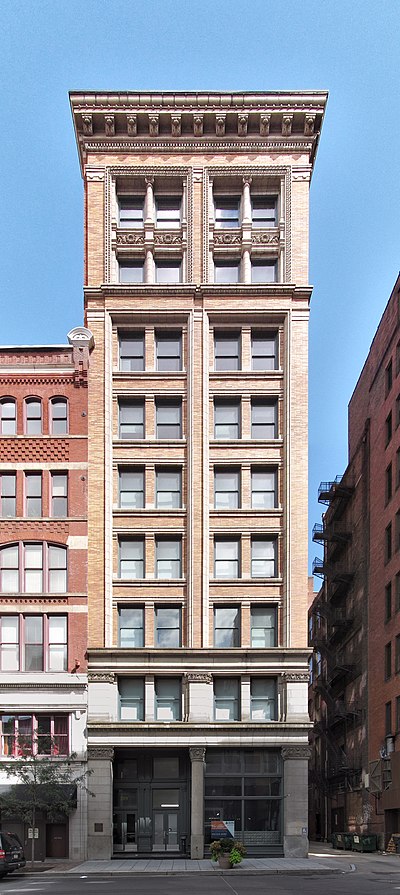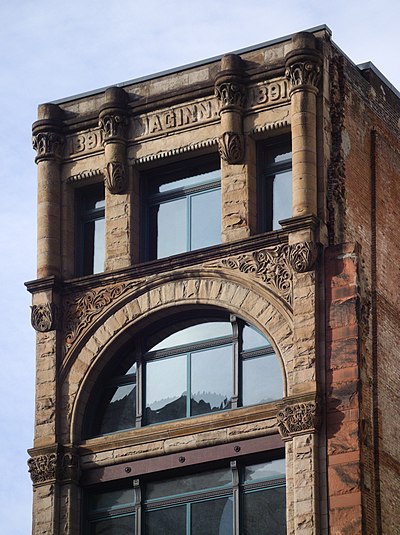Charles Bickel

From Palmer’s Pictorial Pittsburgh.
The Granite Building, 1890
One of our most prolific architects, Charles Bickel was also one of our most stylistically versatile. He was a whiz at Richardsonian Romanesque, but he could turn on a dime and give you a perfect rendition of Beaux-Arts classicism if that was what you wanted.
United Presbyterian Board of Publications Building, 1895
His Wikipedia article gives us an incomplete list of Bickel’s buildings, which we adapt and enlarge under the Creative Commons Attribution-ShareAlike License 3.0. Links in the list go to articles at Father Pitt’s main site.
Logan-Gregg Hardware Company building, eight storeys.
Spear & Company, ten storeys
May Building, twelve storeys
German National Bank, eight storeys, 1890
Columbia National Bank, ten storeys
Methodist Book Concern building, eight storeys
United Presbyterian Book building, eleven storeys
Maginn Building, 1891
Ewart Building, 1892
Engine House No. 22, Arlington/South Side Slopes
H. and I Kaufman and I. Kaufman stores, ten and twelve storeys, 1898
Hartje Building, twelve storeys, and three Hartje stores
B. White Building, eight storeys
Atlantic Financial Building, 1889
Pittsburgh Terminal Warehouse and Transfer Company, 1906
Haines Building, ten storeys
McKay Building, eight storeys
Olympia Theatre
Reymer Brothers Candy Factory, 1910
Concordia Club, 1913
Second Presbyterian church, Eighth Street
South Side Market Building, 1915
Frank & Seder Building, 1918
Methodist Episcopal Church, Lincoln Avenue
German Savings and Trust Company
Duquesne National Bank
National Ben Franklin Fire Insurance Company Building
Westmoreland Club, in Verona, Pennsylvania
N. Nathan & Brothers Building, Johnstown, Pennsylvania
Number 7 Police Station, 93 S. 13th and 1305 Sarah St. (demolished)

Hartje Building (West Penn Building)
A long biography appears in one of the biographical volumes of George T. Fleming’s History of Pittsburgh and Environs, and we reprint it in full here, including the section on Bickel’s son Walter:
CHARLES BICKEL—For more than thirty-five years the name of Charles Bickel was a power in the building world of Western Pennsylvania, and was widely known outside the State. As one of the leading architects of the day, he left the stamp of his personality on literally thousands of buildings in the city of Pittsburgh and elsewhere.
Charles Bickel was born in Columbus, Ohio, in 1852, and attended the public schools of that city. Of broad mentality and artistic tastes, his natural bent was towards architecture and the classics. He was sent to Europe to prepare for his career, and spent six years there, studying architecture. Returning to this country in 1875, and seeking a promising location, he determined upon Pittsburgh, which became the scene of his achievement. He started in business in this city on Nov. I, 1885, and for a short time J. P. Brennan was associated with him as a partner, but Mr. Brennan soon withdrew from the firm, and Mr. Bickel was thereafter alone. He did probably more work than any other architect in the State of Pennsylvania, his plans averaging yearly close to $3,000,000 in building construction, or about $100,000,000 for the period of his activity in this field. Among the more important buildings designed and erected under the supervision of Mr. Bickel (the list, however, including only a very small fraction of his total work) are the following structures: The Logan-Gregg Hardware Company building, eight stories in height; the buildings of Spear & Company, ten stories; May building, twelve stories; the German National Bank, eight stories; the Columbia National Bank, ten stories; the Methodist Book Concern building, eight stories; the United Presbyterian Book building, eleven stories; the Hartje office building, twelve stories; the B. White building, eight stories; the two buildings of the Kaufman store, ten and twelve stories; the great structure of the Pittsburgh Terminal & Warehouse Company; the Haines building, ten stories; and the McKay building, eight stories; the above being all buildings of fireproof construction. Of “slow-combustion” buildings there are the H. & I. Kaufman and the I. Kaufman stores; the L. Schlather and the Sunstein buildings; the three Hartje stores, one seven and two eight stories in height; the Reymer Brothers building; the Mackey bakery; the Grey building; the Boggs & Buhl store and warehouse; the Pottery buildings at Newel, W. Va.; the Olympia Theatre; Irene Kaufman Settlement building; Marietta Chair Company, ten stories; Lyle building; Second Presbyterian Church, Eighth street; Lincoln avenue Methodist Episcopal Church; German Saving & Trust Company; the Solomon’s office building; the Arbuthnot and Ewart stores, each nine stories in height; and upwards of fifty others of lesser dimensions. Among other structures of particular interest are: The Duquesne National Bank ; the. Concordia Club; the National Ben Franklin Fire Insurance Company’s office building, all of Pittsburgh; the Westmoreland Club, of Verona, Pa.; the N. Nathan & Brother’s building, Johnstown; and many other buildings in various cities of Pennsylvania and many other states. He was for a number of years city architect and designed a number of public buildings, the Public Safety building and several of the city’s police stations being examples of his work. About Jan. 1, 1920, Mr. Bickel was compelled, through failing health, to give up his business interests and place them in the hands of his son. He died Feb. 1, 1921.
In the civic, fraternal and social organizations of which Mr. Bickel was a member his name will long be honored. He was a member of the American Institute of Architects, and a life member of the Pittsburgh Chamber of Commerce. Fraternally, he was a member of Washington Lodge, Free and Accepted Masons; Duquesne Chapter, Royal Arch Masons; Mount Moriah Council, Royal and Select Masters; Tancred Commandery, Knights Templar; Pennsylvania Consistory, Ancient Accepted Scottish Rite; and was also a member of Syria Temple, Ancient Arabic Order Nobles of the Mystic Shrine. He was a member of the Duquesne Club, the Civic Club, and in political affiliation was a Republican. His religious convictions placed his membership with the Seventh United Presbyterian Church.
Charles Bickel married Emma Cappell, and they were the parents of two children: Walter J., of whom extended mention follows; and Florence Emma, who was educated in the Pittsburgh public and high schools, and the Pennsylvania College for Women, and is now the wife of George W. Swan, a Pittsburgh attorney.
Walter J. Bickel was born in Pittsburgh, Aug. 2, 1880, and his first school attendance was at the Hatfield public school, then later he was a pupil at the Washington public school. Taking a preparatory course at Park Institute, he entered Gettysburg College, from which he was graduated in the class of 1902. He has followed various activities, and until recent years spent the greater part of his time in the West. His first business association was with the Carnegie Steel Company, with whom he remained for one year, then was connected with his father’s business for a period of three years. Thereafter going to Arizona, he established a business as architect and builder, and later became interested in mining and prospecting, and was identified for a considerable time with the United States Reclamation service. In 1914 he came back to Pittsburgh, remaining for four years. He then returned to Arizona, where he owns a ranch, and looked after his interests there until his father’s failing health called him East again, in 1920, and he has since carried on the business which his father laid down, attaining a high position in the field of architecture. His work includes the annex to the Diamond National Bank building, and a large department store for M. Nathan & Bros., Johnstown, Pa. He is a member of Arizona Lodge, No. 2, Free and Accepted Masons, of the Chamber of Commerce, and his college fraternity is the Phi Delta Theta. He supports the Republican party in affairs of both local and national import, and is a member of the Lutheran church.
On July 25, 1908, Mr. Bickel married, in Arizona, Nell Rhodes, who is a native of Michigan, and a member of one of the pioneer families of that State. An ancestor of Mrs. Bickel was a British soldier, about 1777, serving with his command in the Revolutionary War; he decided to cast in his lot with the struggling colonies, and at the expiration of his enlistment joined the Continental army.

Pittsburgh Terminal Warehouse & Transfer Co., 1906
Top of the Maginn Building, 1891
Logan-Gregg Hardware Co. Building, 1915
For a longer list, see Father Pitt’s Great Big List of Buildings and Architects, which is kept up to date with old Pa Pitt’s latest research.



